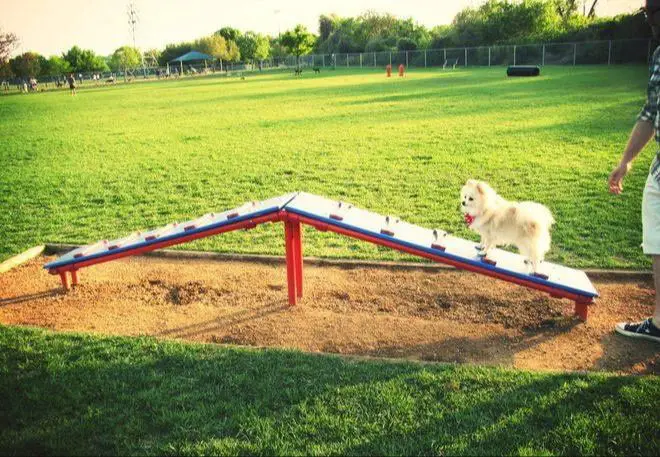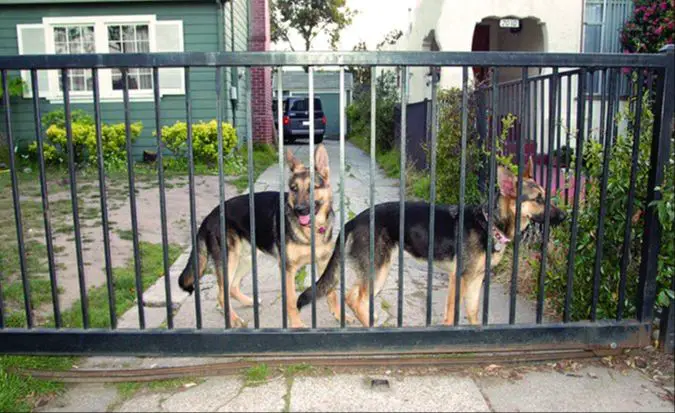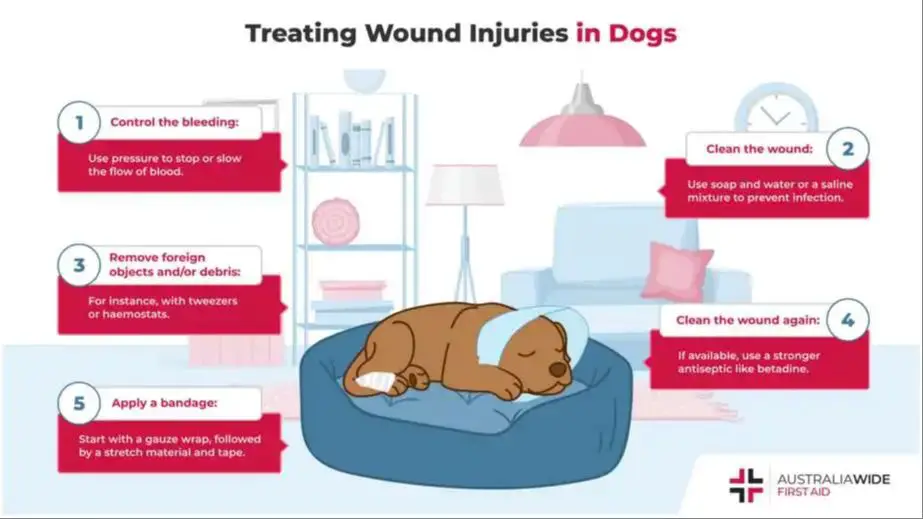What is a Dog Park?
A dog park is an enclosed outdoor area that allows dogs to exercise and socialize off-leash in a controlled environment. Dog parks provide a safe space for dogs to run around and play with other canines.
Dog parks typically have the following features:
- Fencing – The area is fully enclosed to keep dogs safely inside.
- Double gated entry – This allows pet owners to unleash their dogs inside the second gate before entering the park.
- Benches – For dog owners to sit and supervise their pets.
- Waste bags and trash cans – To maintain cleanliness in the park.
- Water fountains – For dogs to stay hydrated.
- Agility equipment – Such as tunnels, hurdles, weave poles for dogs to play on.
- Separate areas – Some parks have separate spaces for small and large dogs.
The main purpose of a dog park is to provide a safe, designated area for dogs to exercise, play, and socialize off-leash without endangering or disturbing the general public.
Benefits of a Backyard Dog Park

A backyard dog park can offer a number of benefits for both you and your furry friend. Here are some of the key advantages:
Exercise
Backyard dog parks provide a safe, enclosed space where your dog can run around and get the exercise they need. The space allows them to run freely and play fetch, helping them release pent-up energy and prevent problem behaviors that can arise from boredom or confinement.
Socialization
If you have multiple dogs, a backyard dog park allows them to interact and play together. It provides valuable socialization opportunities in a controlled environment. Socializing is important for a dog’s development and overall wellbeing.
Convenience
With a dog park right outside your door, you avoid having to drive and load up your dog just for them to be able to run around. A backyard dog park provides daily opportunities for exercise and playtime in a convenient location close to home.
Space Requirements

When deciding if your backyard is suitable for a dog park, space is one of the most important considerations. The amount of room dogs need depends on factors like their size, energy level, and how many you plan to have in the park at once. Here are some general space recommendations:
For a single large breed dog like a Labrador or German Shepherd, aim for at least 400-600 square feet of usable space. This allows enough room for running, playing fetch, and other activities. Smaller breeds like Corgis or French Bulldogs need less room, around 200-300 square feet.
If multiple dogs will use the park, add more space. For 2-3 large breed dogs, plan for 800-1000 square feet. Up to 5 large dogs need around 1500 square feet. Scale down accordingly for smaller breeds. More dogs means more running around, so extra space prevents conflicts.
Check your city’s zoning laws too. Many have rules about structure sizes and setbacks on residential property. Make sure your plans conform to local regulations before constructing a backyard dog park.
Fencing

Proper fencing is critical for containing your dog and keeping unwanted animals out of the backyard dog park. When choosing fencing material, durability and height are key factors. Metal and wood fencing are popular options that provide security and are aesthetically pleasing.
For maximum safety and containment, fencing should be at least 6 feet tall. Shorter fencing poses a risk of dogs jumping or climbing out. Masonry and chain link fencing at least 5 feet tall can also work well. Include a double gated entry, with two gates separated by a small enclosure, to prevent any escapes.
Wooden privacy fences made of cedar or redwood are attractive but can be chewed or scratched. Wrought iron and aluminum provide a timeless look with added reinforcement at the bottom to discourage digging. Vinyl coated wire mesh is very durable and easier to maintain than wood. Ultimately the best fence depends on your budget and visual preferences.
Surfacing
The surface material for your backyard dog park is an important consideration for safety, aesthetics, drainage, and maintenance. Here are some of the most popular options:
Grass
Grass is a natural choice that offers a softer surface for dogs to run and play on. However, it requires regular mowing, fertilizing, and irrigation to stay lush and healthy with dog traffic. Grass can also get muddy when wet.
Mulch
Wood mulch provides a natural looking surface that absorbs urine and is comfortable under paws. However, it can retain odors, require frequent raking, and need replenishing over time. Organic mulches like bark and wood chips are good choices.
Gravel
Small pea gravel creates a smooth, draining surface but may get kicked out of the play area. Larger gravel is harder to maintain and can hurt paws. Be sure to use rounded river rock rather than sharp angular gravel.
Artificial Turf
Artificial grass and turf are clean, durable options that don’t need watering or mowing. Look for pet-friendly types with antimicrobial protection, drainage holes, and a soft layer beneath for cushioning. Higher quality artificial turf can be pricey upfront but is very low maintenance.
Amenities
A backyard dog park should have some basic amenities to make it enjoyable for your pet. Some key amenities to consider including are:
Benches
Having benches or seating in your backyard dog park allows owners to comfortably supervise their dogs at play. Benches also provide a place to sit while taking a break. Select durable, weather-resistant benches that can withstand the outdoor elements.
Shade
Providing shade is important to protect dogs from getting overheated on sunny days. Options for shade include shade trees, shade sails, or a shade structure. Make sure to position the shade so it covers areas for both pets and owners.
Water
Include access to fresh water for dogs to stay hydrated. You can use dog water fountains/bowls, or integrate a small pond that is safe for pets to drink from. Place water sources in multiple spots around the backyard dog park.
Toys
Having a variety of toys helps keep dogs engaged and active. Rotate different toys to maintain interest. Durable chew toys, balls, Frisbees, tunnels, and other interactive toys are great to include. Monitoring playtime is still important to avoid conflicts over toys.
Maintenance

Having a dog park in your backyard will require some regular maintenance to keep it clean, pest-free, and functioning properly. Here are some things to consider for maintaining your backyard dog park:
Cleaning
Dog parks can get messy with waste, mud, and debris. Plan to pick up dog waste and dispose of it properly at least once daily. Hose down areas as needed to wash away mud, dirt, and urine. Clean up any trash or debris from play items, plants, etc. Allow it to fully dry before letting dogs back in.
Pest Control
Stay on top of pest control to keep fleas, ticks and other pests away. Treat the ground periodically with pest control sprays or powders safe for pets. Check your dogs regularly for any signs of pests after time in the park. Trim back plants and bushes around the perimeter to discourage pests.
Upkeep
Conduct regular inspections of fencing, gates, play equipment and surfacing for damage. Make any needed repairs promptly. Replenish play surface materials like gravel or mulch if they get scattered or depleted. Trim and prune landscaping as needed. Consider reseeding grass periodically in high traffic areas. Keeping up with maintenance will extend the life and safety of your backyard dog park.
Safety
When creating a backyard dog park, safety should be a top priority. Proper supervision, establishing rules, and keeping vaccinations up to date can help keep your backyard dog park safe.
Always supervise dogs when they are using the backyard dog park, even if they normally get along. Dogs can get carried away when playing and supervision helps prevent any injuries or fights from breaking out. Have one person dedicated to watching the dogs at all times.
Establish clear rules for use of the space that dogs must follow, such as no rough play, no toys that could cause possessive behavior, and taking turns with equipment. Make sure dogs obey commands to “leave it”, “drop it”, and “settle down” so you can easily intervene if needed.
Require updated vaccinations for all dogs using the park. Rabies, distemper, parvo, and bordetella vaccines can help prevent contagious illnesses from spreading. You may also require flea/tick prevention to keep the area pest free.
With proper supervision, rules, and health precautions, you can make your backyard dog park a safe place for pets to play and socialize.
Costs
When creating a dog park in your backyard, some of the major costs will be fencing, surfacing, and amenities. Here’s a breakdown of typical costs for these elements:
Fencing
For fencing, you’ll likely want to use a durable material that can withstand dogs jumping on it. Chain link fencing often used in dog parks can cost $15-30 per linear foot installed. More heavy-duty options like vinyl coated fencing can cost $25-50 per linear foot. For a small backyard space of say 400 sq ft, you may need around 100 linear feet of fencing which could cost $1,500-$5,000 depending on materials.
Surfacing
Common surfacing materials for dog parks include pea gravel, mulch, artificial turf, and poured rubber. Pea gravel is a budget-friendly option at around $1-3 per square foot. Mulch is similarly inexpensive at $1-2 per square foot. Artificial turf and poured rubber cost more, from $3-8 per square foot, but provide added durability and drainage. For a 400 sq ft space, surfacing could cost $400-$3,200 depending on your material selection.
Amenities
Optional amenities like agility equipment, shelters, benches, and water fountains can enhance your backyard dog park. These add-ons can range from $500-$2,000 depending on what you choose. Shop around to find affordable options.
In total, you may spend anywhere from $2,500 to $10,000+ creating your backyard dog park, with fencing, surfacing, and amenities as the primary costs.
Permits and Regulations
Before converting your backyard into a dog park, it’s important to check local zoning laws, noise ordinances, and building codes. Failing to get proper permits and follow regulations could result in fines or even having to undo your hard work.
Most residential areas have zoning restrictions on business uses of property. Since a commercial dog park involves paying customers, zoning may be an issue. Check with your local zoning board to see if a backyard dog park is allowed or requires a permit. You may need to file for a variance or conditional use permit if the zoning doesn’t conform.
Noise is also a major consideration. Multiple dogs barking throughout the day could violate local noise ordinances, especially in suburban areas. Research the decibel limits and time-of-day restrictions in your municipality. Acoustically treating fences and landscape buffers may help mitigate noise.
Additionally, any major landscaping, surfacing, or construction will need to comply with building codes and permits. Grading and drainage work, in particular, often requires approval. Electrified dog fencing systems may also need inspected. Doing work without proper permits can lead to expensive fixes down the road.
By thoroughly researching the regulations and proactively involving local officials, you can avoid hassles and create a legally compliant dog park that is welcomed by the community.